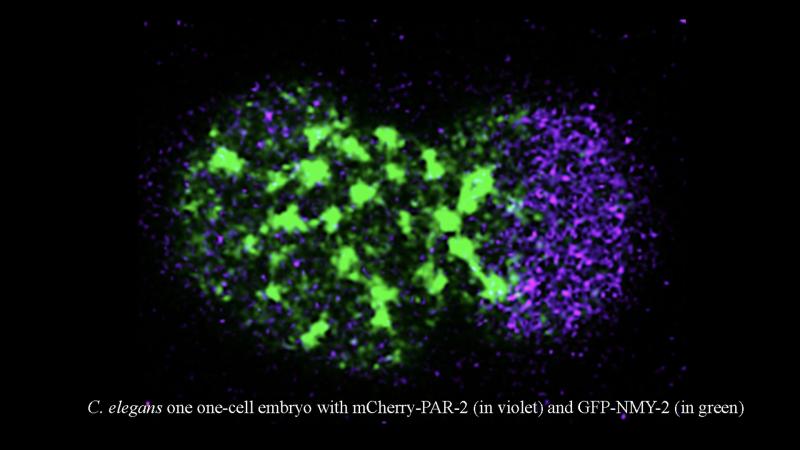
Humans, like several other organisms, have many types of cells in their body—blood cells, nerve cells, skin cells, and so on. These different types of cells work together to maintain the functions of the various organs in our body and play a vital role in our survival. These cells multiply through a process called cell division or cytokinesis, a complex and continuously occurring process within our body. Any impediments in this process could result in diseases such as cancer or anaemia.
Within each specialised cell, there are a few spatial and functional differences that enable them to carry their functions. For example, a red blood cell would need to be able to travel through the body and bind to oxygen, while a nerve cell’s primary function would include transmitting electrical and chemical signals to neighbouring cells. Cell polarity refers to these spatial differences within a cell, including the shape, size, or organisation of the cellular components.
Several interacting molecular and biochemical processes are vital to establishing cell polarity. In a recent study, researchers at the Indian Institute of Science, Bengaluru, studied some of these signals in the centrosome—an organelle in the cell responsible for cellular organisation—of a single-cell embryo. They studied a fertilised embryo of the roundworm (Caenorhabditis elegans) to understand how polarity is established. C. elegans is widely used in research because its genome can be easily manipulated and it shares several genes and molecular pathways with humans. The study, published in the journal Development was funded by the Department of Biotechnology (DBT)-Indian Institute of Science Partnership Program and the Wellcome Trust- DBT India Alliance Fellowship.
“In the one-cell C. elegans embryo, the centrosomes were known to be essential for polarity establishment,” says Dr Sachin Kotak from IISc, who led the study.
Previous research has found that there exists a direct correlation between the timing of polarity set-up and the distance between the centrosome and the cell cortex—the inner part of the cell membrane. The higher the distance, the longer it takes to establish polarity.
“This observation suggested that there could be some sort of gradient of a key component emanating from the centrosome, which is critical for proper polarity set-up. However, the nature of this key component was not known for a long time,” he adds.
Besides, actomyosin-based contractions at the cell cortex are also crucial in establishing polarity. These contractions ensure that the evolutionarily-conserved proteins, known as partition defect proteins (PARs), are accurately distributed at the cell surface. Hence, the centrosomes and cortical contractions play an important role in regulating the polarity during the development of the embryo. Previous studies have also shown that the correct polarity is vital to the beginning of the polar axis formation—a process by which a geometric axis is formed, leading to cell division along that axis.

Credits - Dr. Sachin Kotak
The researchers in this study focused on Aurora A kinase (AIR -1), an enzyme involved in the addition of a phosphate group (PO4) to proteins. The Aurora family comprises of different enzymes, all of which are vital to the various processes which occur during mitotic and meiotic cell division. The AIR-1 is of particular interest in cancer research, since many human cancers have been correlated with an increased expression of this enzyme and subsequently, unchecked cell division and proliferation.
“We were lucky in identifying this key component of polarity set-up,” remarks Dr Kotak, explaining how the experiment began. “It is one of more than hundreds of proteins on the centrosome, and we were able to specifically identify its role in polarity establishment when we uncovered that the loss of Aurora-A in early embryos leads to polarity defects,” he details.
The researchers studied the role of AIR-1 in polarity initiation by suppressing its production in the cell. The development of AIR-1-suppressed embryo was compared with a healthy embryo to understand the role of AIR-1 in cell polarity establishment.
The study found that a loss of AIR-1 can result in higher tension in the cell cortex, which in turn results in establishing more than one polarity axis along which cell division occurs. As a result, abnormal progeny cells are formed. The PAR-2 proteins, which are otherwise localised to the posterior cell membrane, was found in the anterior and posterior cell surfaces. The researchers also established the importance of kinase active AIR-1 in the maintenance of proper cortical tension and a single polarity axis.
Earlier work has shown that AIR-1 plays an essential role in microtubule organisation at the centrosome. The centrosome gives a cell its structure by organising microtubules—protein-based structures that extend throughout the cell, supporting it and keeping other organelles in place. Depleting AIR-1 had significant effects on the number of microtubules. Since microtubules are implicated in proper polarity set-up, they studied whether a decrease in the number of microtubules upon AIR-1 loss is the causative reason for polarity defect. Notably, by conducting a number of experiments they concluded that microtubules are not critical in the context of AIR-1 for proper polarity setup.
Lastly, the researchers found that in one-cell embryos with depleted AIR-1, the establishment of an axis for cell division was independent of the position of the centrosome. In a healthy cell, these two functions are interconnected, and the polar axis formation is mostly dependent on the centrosome. However, the centrosomes in AIR-1 depleted cells no longer have the ability to govern axis formation, and instead, these occur at multiple axes of the cell cortex.
The findings of the study demonstrate the role of AIR-1 in the process of polarity establishment and cell division. Since numerous molecular and biochemical processes occur in our cells continuously, and in tandem, studying a single molecule or pathway within this tangled system paves the way for more in-depth research. Such studies have great potential to better understanding of stem cell biology and the development of organisms, including humans.
“Proper polarity set-up in a developing embryo is essential because it helps in the accurate segregation of the cell fate determinants along different axes. If the polarity is not established in any cell, it can lead to embryonic lethality,” explains Dr. Kotak. "Our work implicates an evolutionarily-conserved protein, Aurora-A, in this process, and we propose that its function will be critical not only in invertebrates like C. elegans, but even beyond that,” he signs off.
This article has been run past the researchers, whose work is covered, to ensure accuracy.

























